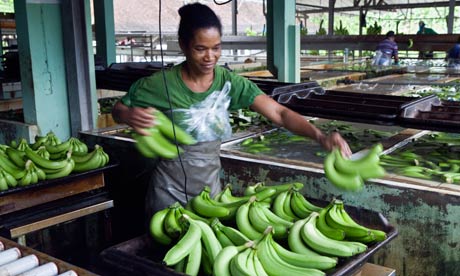
France is once again embroiled in a health and safety scandal. For 20 years, from 1973 to 1993, the insecticide chlordecone (Kepone) was used in Martinique and Guadeloupe, in the French West Indies, to combat banana weevil, exposing a significant proportion of the population and polluting the soil.
A study published last month in the Journal of Clinical Oncology and in Guadeloupe confirms that chlordecone, which disrupts the endocrine system, is responsible for a significant increase in the risk of prostate cancer, the cause of half the cancers detected on the two islands.
“Huge mistakes were made, horribly reminiscent of the key public health issues of the 1980s and 1990s, particularly growth hormones and BSE,” says Professor William Dab, the head of the Science Committee for the Martinique and Guadeloupe Chlordecone Plan. The product was banned in mainland France in 1990 but special provision was made for its use to continue in the Antilles until 1993. It had been banned in the US since 1976.
“As parliamentary reports have already shown, the ministry of agriculture failed to register the scientific data on the dangers of pollution and exposure to chlordecone. It took time for the message to sink in and for them to act,” Dab says. The first local measures were introduced in 1999. Only in 2004 was allowance made for chlordecone in France’s Environmental Health Plan. Dab’s committee finalised its report in October last year but the government did not actually publish it until 17 June, when it was posted on the Institute for Public Health Surveillance website.
Martinique and Guadeloupe must now cope with massive contamination of soil, river water and sediments by a substance that remains toxic for centuries. “About 80,000 people live in areas were the soil is contaminated and 13,000 absorb more chlordecone than the reference dose per day, simply by eating their own vegetables. We must help local people learn how to live with a problem which is here to stay: the half-life of chlordecone in the ground – the time it takes half the quantity present to disappear – is 600 years,” Dab says.
From 2004 to 2007 a joint team from France’s Institute of Health and Medical Research and the urology department at the general hospital in Pointe à Pitre carried out a study to identify and characterise the environmental, genetic and hormonal risk factors for prostate cancer in the Antilles. It investigated more than 600 men with prostate cancer and an equivalent number of controls.
According to the results of the study, which has now been published, the risk of prostate cancer increases with higher levels of chlordecone in the blood. Exposure to the pesticide is associated with a higher risk of developing prostate cancer. The risk is even higher for those with a history of prostate cancer in their family, and for those who lived for some time in a western country.
This diagnosis could, in the first case, be due to common factors of genetic predisposition to the disease and sensitivity to chlordecone exposure. Living in a western country, with the environmental hazards that involves, could be associated with other carcinogenic factors, or with changes in eating habits.
The study reveals a substantial increase in the risk of prostate cancer among men exposed to chlordecone. But eating contaminated foodstuffs incurs a much higher risk than simply handling the product.
This article originally appeared in Le Monde
Deprecated: strpos(): Passing null to parameter #1 ($haystack) of type string is deprecated in /home/agriviek8Qv/agriviet.net/public_html/wp-includes/comment-template.php on line 2522